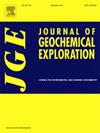Geochemistry and economic evaluation of REE + Y potential in the fine-grained matrix of sedimentary phosphorites from the Tebessa region, eastern Algeria
IF 3.3
2区 地球科学
Q1 GEOCHEMISTRY & GEOPHYSICS
引用次数: 0
Abstract
The Algerian phosphorites, deposited during the Paleocene-Eocene, are part of the Tethyan phosphogenesis along the southern paleo-Tethys margin. Located primarily in the Tebessa region, these deposits hold reserves exceeding 2 billion metric tons. Recent interest has grown due to their enrichment in rare earth elements plus yttrium (REY). While previous studies have examined whole-rock and grain-size fractions, the fine-grained matrix (<45 μm) remains poorly explored. This study provides the first mineralogical and geochemical characterization of this fraction to assess its economic potential and paleoenvironmental significance. Twenty-two fine-fraction samples from four Tebessa localities were separated using humid grain-size classification. Mineralogical analysis was supported by X-Ray Powder Diffraction (XRD), whereas geochemical analyses were carried out using inductively coupled plasma optical emission spectroscopy (ICP-OES) and inductively coupled plasma mass spectrometry (ICP-MS).
The XRD results show that the phosphorite fine-grained matrix is composed of calcite, dolomite, carbonate fluorapatite, glauconite, quartz, chlorite, and gypsum. Notably, glauconite occurs in higher amounts in southern deposits (Kef Essenoun), suggesting intensified glauconitization process. Geochemically, the fine fraction contains an average of 12.48 wt% P2O5, with REY concentrations ranging from 55 to 863 ppm. REY contents increase southward, with REEs ranging between 68 and 678 ppm (avg. 416 ± 198 ppm) and Y varies from 9 to 187 ppm (avg. 125 ± 56 ppm). The higher REY content is partly linked to glauconite phase abundance. Normalized REY contents indicate seawater-like patterns in the northern deposits, whereas the southern deposits show middle REE (MREE) enrichment patterns. High (La/Yb)N ratios in the glauconite-rich samples suggest early-diagenetic adsorption under slow sedimentation rate and sub-reduced conditions. An enhanced glauconitization process occurred in the southern basin at the Paleocene–Eocene boundary, which is marked by global thermal event. These findings suggest that the fine-grained matrix, typically considered as waste during the treatment of raw phosphorites, holds economic potential due to its high REY content, presenting a promising resource for future exploitation.

阿尔及利亚东部Tebessa地区沉积磷岩细粒基质中REE + Y电位地球化学及经济评价
阿尔及利亚磷矿沉积于古新世-始新世,是古特提斯南部边缘磷矿的一部分。这些矿床主要位于Tebessa地区,储量超过20亿吨。由于它们在稀土元素和钇(REY)中富集,最近的兴趣越来越大。虽然之前的研究已经检测了整个岩石和颗粒大小的组分,但对细粒基质(45 μm)的研究仍然很少。本研究首次提供了该组分的矿物学和地球化学特征,以评价其经济潜力和古环境意义。采用湿粒度分类方法对4个地区的22个细粒样品进行了分离。矿物学分析采用x射线粉末衍射(XRD)进行,地球化学分析采用电感耦合等离子体发射光谱(ICP-OES)和电感耦合等离子体质谱(ICP-MS)进行。XRD结果表明,磷矿细粒基质由方解石、白云石、碳酸盐氟磷灰石、海绿石、石英、绿泥石和石膏组成。值得注意的是,海绿石在南部沉积物中含量较高(Kef Essenoun),表明海绿石化过程加剧。地球化学特征表明,细粒P2O5平均含量为12.48 wt%, REY浓度为55 ~ 863 ppm。REY含量向南增加,ree含量在68 ~ 678 ppm(平均416±198 ppm)之间,Y含量在9 ~ 187 ppm(平均125±56 ppm)之间。较高的REY含量与海绿石相丰度有关。归一化的REY含量在北部矿床表现为类似海水的富集模式,而南部矿床则表现为中等REE (MREE)富集模式。富海绿石样品的高(La/Yb)N比值表明在缓慢沉积速率和亚还原条件下的早成岩吸附作用。盆地南部古新世-始新世界线处发生了一次强化的海绿石化作用,以全球热事件为标志。这些发现表明,细粒基质通常被认为是原磷矿处理过程中的废物,但由于其REY含量高,具有经济潜力,是未来开发的有前景的资源。
本文章由计算机程序翻译,如有差异,请以英文原文为准。
求助全文
约1分钟内获得全文
求助全文
来源期刊

Journal of Geochemical Exploration
地学-地球化学与地球物理
CiteScore
7.40
自引率
7.70%
发文量
148
审稿时长
8.1 months
期刊介绍:
Journal of Geochemical Exploration is mostly dedicated to publication of original studies in exploration and environmental geochemistry and related topics.
Contributions considered of prevalent interest for the journal include researches based on the application of innovative methods to:
define the genesis and the evolution of mineral deposits including transfer of elements in large-scale mineralized areas.
analyze complex systems at the boundaries between bio-geochemistry, metal transport and mineral accumulation.
evaluate effects of historical mining activities on the surface environment.
trace pollutant sources and define their fate and transport models in the near-surface and surface environments involving solid, fluid and aerial matrices.
assess and quantify natural and technogenic radioactivity in the environment.
determine geochemical anomalies and set baseline reference values using compositional data analysis, multivariate statistics and geo-spatial analysis.
assess the impacts of anthropogenic contamination on ecosystems and human health at local and regional scale to prioritize and classify risks through deterministic and stochastic approaches.
Papers dedicated to the presentation of newly developed methods in analytical geochemistry to be applied in the field or in laboratory are also within the topics of interest for the journal.
 求助内容:
求助内容: 应助结果提醒方式:
应助结果提醒方式:


